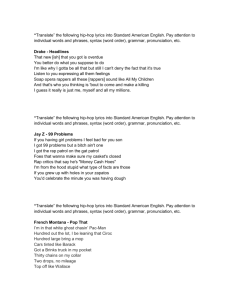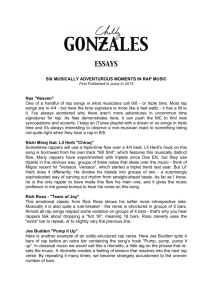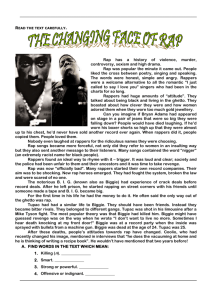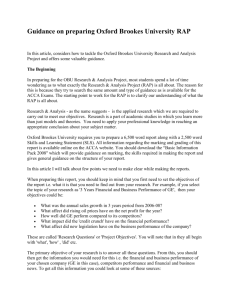evaluation essay Marissa
advertisement
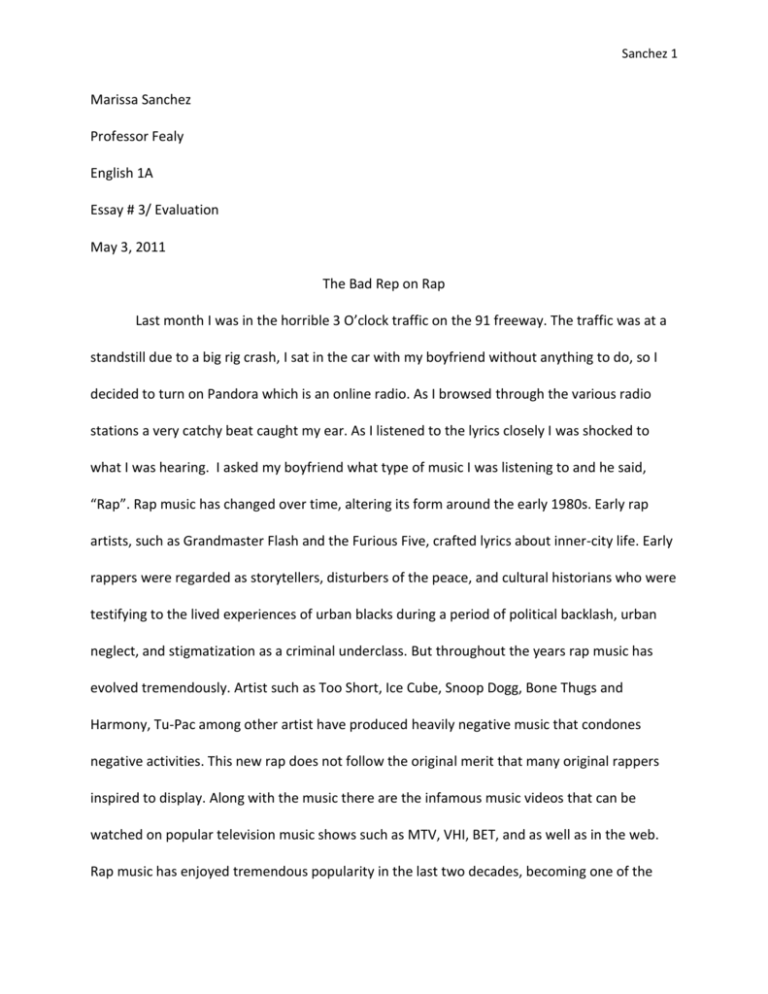
Sanchez 1 Marissa Sanchez Professor Fealy English 1A Essay # 3/ Evaluation May 3, 2011 The Bad Rep on Rap Last month I was in the horrible 3 O’clock traffic on the 91 freeway. The traffic was at a standstill due to a big rig crash, I sat in the car with my boyfriend without anything to do, so I decided to turn on Pandora which is an online radio. As I browsed through the various radio stations a very catchy beat caught my ear. As I listened to the lyrics closely I was shocked to what I was hearing. I asked my boyfriend what type of music I was listening to and he said, “Rap”. Rap music has changed over time, altering its form around the early 1980s. Early rap artists, such as Grandmaster Flash and the Furious Five, crafted lyrics about inner-city life. Early rappers were regarded as storytellers, disturbers of the peace, and cultural historians who were testifying to the lived experiences of urban blacks during a period of political backlash, urban neglect, and stigmatization as a criminal underclass. But throughout the years rap music has evolved tremendously. Artist such as Too Short, Ice Cube, Snoop Dogg, Bone Thugs and Harmony, Tu-Pac among other artist have produced heavily negative music that condones negative activities. This new rap does not follow the original merit that many original rappers inspired to display. Along with the music there are the infamous music videos that can be watched on popular television music shows such as MTV, VHI, BET, and as well as in the web. Rap music has enjoyed tremendous popularity in the last two decades, becoming one of the Sanchez 2 most dominant forms of popular culture. As I continue to sit in traffic and listen to the rap song, I wonder why anyone would want to listen to such appalling music. Another reason why Rap is so terrible is due to the violence. Many rappers come from urban parts of America and the ghetto and are part of gangs. Also rappers form feuds with other rappers who claim opposing coasts. This is all true in the case of Tu-Pac Shakur and Biggie Small who where rappers back in the 90’s. Tu-Pac claimed the west coast, whereas Biggie Smalls claimed the east coast; their feud was displayed in their lyrics where they slandered each other and what they claimed. According to Gwen Hunnicutt “Tu- Pac’s and Biggies feud had gone too far for way too long, the frustration led to both of their deaths” (Hunnicutt 1). Their death can essentially be associated with gang association because gang’s are based on one group claiming a particular street or neighborhood. The opposite gang and the consequences of them not agreeing with each other leads to homicide. According to Jeff Lead of the New York Times, “Rappers exploit violence and sexism for profit” (Leeds 2). Music videos are a significant part of Rap. Money plays a big role in music videos. Rappers flaunt everything that they presume to have due to their success of their rapping career, but in reality the mansions, expensive cars, money, and the beautiful women is not the realty that they live in. The mansions and the cars are either borrowed or rented for the day. The massive amount of money that they flash in the music videos does not exist and the women are higher for the day to be eye candy for the audience. This false life that is displayed in music videos is thought to be real by fans of rap especially those who admire to be like them. They believe one day if they are rappers they will too have the cars, mansion, money and Sanchez 3 women because of the altered dream that rappers portray in their videos. Moreover, music videos at times are very pornographic According to Kandel Leeds “The song Tip Dril by the Rapper Nelly was released in 2004 which stirred up some controversy especially with the women of Spelman College. They said that the video was degrading to women and were very upset for how much air time the video was receiving. The main part of the video that they were upset about was when Nelly swipes a credit card through the buttocks of a female stripper” (Katel 2). Videos like Tip Dril can be easily accessed by anyone who wishes to watch them. Than can even be reached by children by looking online in popular sites such as You Tube and Vevo. A major problem with Rap music is the lyrics. Hidden behind catchy beats exist negative lyrics that promote substance abuse. According to Hunnicutt, Gwen, and Kristy Humble Andrews “Too often, however, rap music contains lyrics with negative messages that promote and condone the illegal or high-risk use of alcohol, tobacco and other drugs” (Hunnicutt 1). Young rap fans listen to Rap artistic rap about smoking weed and using other forms of drugs; therefore, kids who may not have guidance in their lives view substance use as something cool. Songs that promote such activity include “The Weed Song” by Bone-Thugs and Harmony, “Smoke Some Weed” by Ice-Cube, and “Pussy, Money, Weed” by Lil Wayne. The song names speak for themselves the primary purpose of these songs is the use and approval of the use of marijuana. Many young listeners admire and emulate rappers. They figure if someone famous on television uses drugs it is okay for them to use as well. Moreover, the lyrics also include profanity. Rap music carelessly uses the words ‘bitch,’ ‘ho,’ and the N-word in their raps. In the popular song by Too Short “Gangsters and Strippers” he raps “From the weeds house straight to the strip club I need get a bitch and get my dick sucked. All I fuck is gangsters and Sanchez 4 strippers….” Such appalling lyrics are heard by many fans and repeated too. Fans of rap will notice that in every other rap line exist profanity and the N-word. Jeff Leeds explains in his article “There is a consensus that there is something really wrong with black people using these words with such glee, meanwhile supporting the billion-dollar industry that wallows in it” (Leeds 1). As long as fans continue to buy rap albums rap artists will continue to fill their lyrics with indecent words that offend women and blacks. According to Michel Marriot of the New York Times writes in his article Rap’s Embrace of ‘Nigger’ Fires Bitter Debate “For the last several years, rap artists have increasingly used "nigger" in their lyrics, repackaging it and selling it not just to their own inner-city neighborhoods but to the largely white suburbs. In his song "Straight Up Nigga," Ice-T raps , "I'm a nigga in America, and that much I flaunt," and indeed, a large portion of his record sales are in white America” (Marriot 1). In rap music, a genre in which millions of listeners adopt the artists' style and language, "nigger" is virtually interchangeable with words like guy and man. The casual use of these words makes it okay to use for anyone which is a wrong message to send to the listeners. Throughout history, music has been used to express a range of emotions, as well as to influence, educate, and inspire. But Rap music has taken the idea of expression too far to where it is insulting. It no longer influences listeners in a positive way; it condones negative activity and use of bad language. Rap music contains inappropriate, offensive, and violent lyrics as well as pornographic music videos. Rap has slowly but surely has increased its fan base from black inner city kids to the white suburbs. But why would anyone want to listen to this type of music. Rap lyrics are creating a negative influence on young adults especially those who inspire to be a Rapper one day. Sanchez 5 Work Cited Hunnicutt, Gwen, and Kristy Humble Andrews. "Tragic Narratives in Popular Culture: Depictions of Homicide in Rap Music." Sociological Forum 24.3 (2009): 611-630. Academic Search Premier. EBSCO. Web. 3 May 2011. Katel, Peter. "Debating Hip-Hop." CQ Researcher 15 June 2007: 529-52. Web. 3 May 2011. LEEDS, JEFF. "Hearing Focuses on Language and Violence in Rap Music." New York Times, The (NY) 26 Sep. 2007, Late Edition - Final, National Desk: 24. NewsBank. Web. 3 May. 2011. Marriot, Michel. “Rap 's Embrace of 'Nigger' Fires Bitter Debate.” New York Times, The (NY) 13 May 2009, Americas Newspaper. Web. 1 May 2011.




